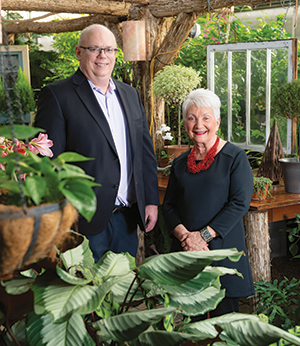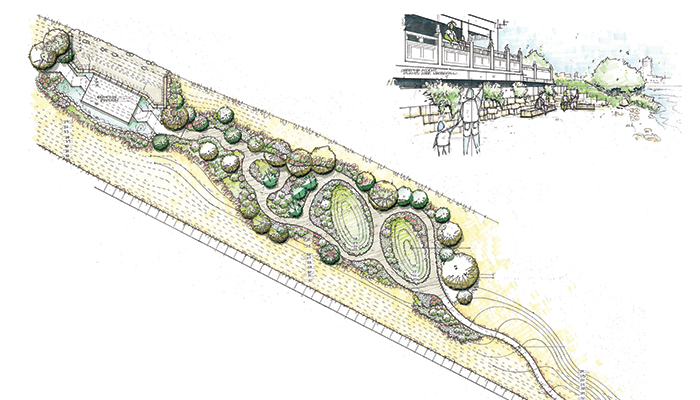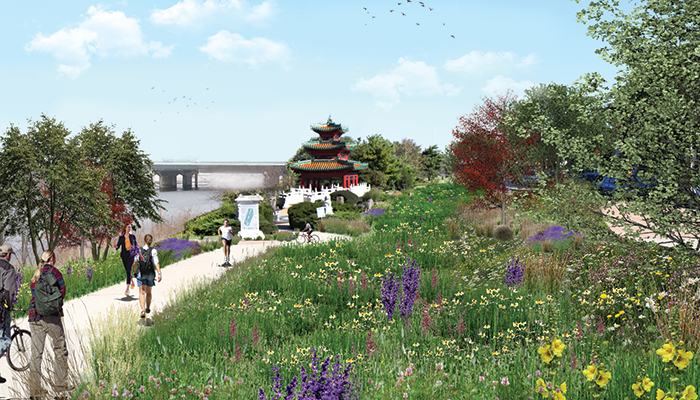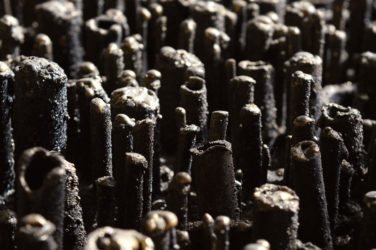Writer: Lisa Lavia Ryan
Photographer: Duane Tinkey
Forty years ago, Gov. Robert D. Ray changed the lives of as many as 10,000 southeast Asian refugees by welcoming them to Iowa, despite skeptics who maintained the state was too racially homogenous to accept such a large minority population.
In recognition of the social contributions of those refugees and their families, and in honor of the public servant who stood firm in his decision to take them in, a group is working to rehabilitate a unique local landmark that bears Ray’s name and commemorates that chapter in the state’s history.
Located along the east bank of the Des Moines River, the Robert D. Ray Asian Gardens and its striking pavilion began falling into disrepair several years ago. Attacks of vandalism in 2017 exacerbated the problem.
People who have cared about the three-story, red-and-green landmark since it was completed in 2009—chief among them Des Moines philanthropist Trudy Holman Hurd—began asking who was responsible for its maintenance. Holman Hurd’s late husband, former Principal Financial Group CEO G. David Hurd, had spearheaded the establishment of a $1 million endowment, held at the Community Foundation of Greater Des Moines, precisely for maintenance of the pavilion. But Holman Hurd wasn’t certain if its condition was beyond the scope of the remaining money.
That inquiry ended up resulting in an effort not only to repair the landmark, but to give it new life. “What we learned was that the amount in the endowment wasn’t adequate to repair damage from vandalism, or repeated issues with the structure’s primary water feature,” Holman Hurd says. “All parties involved with the gardens had, and have, a wonderful relationship, and there seemed to be a feeling among all of us that this thing should be solved.
“So I decided that while I am still on this Earth, I am going to make sure the garden is restored to its original beauty and enhanced even further to teach the community and people who come here about Robert D. Ray and about the people he brought here and cared so much about.”

Restoration and Maintenance
In late 2017, Holman Hurd and several others formed a group called Friends of the Asian Gardens with a goal of raising $1.5 million—$1 million to restore the landmark and an additional $500,000 for the endowment to fund ongoing maintenance. Initially, Holman Hurd was unsure of the likely response, but it didn’t take long for the group to discover people were willing to commit.
“My big wonder was whether people were going to be interested in helping with something that already exists, rather than something shiny and brand-new,” Holman Hurd says. “But we started to see things build rather quickly.
I am grateful that wonderful people in this wonderful city are choosing to become involved.”
As of this issue’s press deadline, about half the money had been raised. Some of the major contributors so far have included Principal, the G. David and Trudy Holman Hurd Community Foundation Donor Fund, Bravo, the W.T. and Edna Dahl Trust, architect Mike Simonson and
Dr. Richard Deming. (Holman Hurd declined to provide specific donation amounts.) Donations at all levels are being sought and welcomed.
Botanical Garden
A key to the effort’s success is the involvement of the Greater Des Moines Botanical Garden, which will assume responsibility for the landmark. Kelly Norris, director of horticulture and education for the Botanical Garden, says the goal is to enhance the Asian Gardens beyond the current scope, renewing broader interest in the pavilion and its surrounding features.
The Botanical Garden has been involved in the renovation plan since the beginning of the campaign “because the project is so enmeshed with the community, and such an important reminder of a key part of our state’s history,” Norris says. “But we’re also involved to the degree that we are because of adjacency. We want the gardens to flourish and become part of a larger cultural process.”
Although plans have not been finalized, Norris says the Botanical Garden’s overarching goals for the project are twofold: to continue to honor Gov. Ray and the contributions of the people he brought to Des Moines, and to enhance the public’s experience along the riverfront.
“We’re in this to add value; this is not a Band-Aid,” Norris says. “We want to expand the scope of horticulture in the entire area. Pure cultural authenticity isn’t really what’s important here; we want to increase the mobility of the site while celebrating the cultural presence.
“If this becomes reality, people can expect to see dynamic horticulture and design—seeing us work with other botanical gardens to bring in [seeds and plants] from wild sources in Asia that are site-appropriate for Iowa,” he adds. “The goal is to create something sustainable and progressive, and resilient for an Iowa-river landscape—and also recognizable culturally as having an Asian influence.”
Stephanie Jutila, president and CEO of the Botanical Garden, says it won’t be possible to establish a firm timeline for the project until the fundraising goal has been met and the Army Corps of Engineers, the Iowa Department of Natural Resources and the Des Moines City Council have approved plans. Norris says the group hopes to build and plant this year and provide a new visual experience in 2020.
‘Strong Bones’
Simonson, who has been involved with the Asian Gardens since the project’s inception, says that even though the pavilion is ornate, it won’t be inordinately expensive for experts to restore it to its original condition.
“It was built in China by master craftsmen using Asian techniques, and it has strong bones,” Simonson says. “It’s heavy timber put together with the resin of tree sap, and it’s the only structure in the United States in which imperial colors were used on the tiles, which were then fired in imperial kilns. It deserves to be brought back to life, and although some elements of it have suffered, it’s a stout structure and it will be fine.”
Simonson adds that as years pass, it’s increasingly important to honor Gov. Ray, his wife, Billie Ray, and the people of Iowa for their response to one of our time’s greatest humanitarian crises. Simonson is working with Holman Hurd and others—including Deming, Principal leaders, and Josh Faber from Renaissance Group Inc., who has helped with grant writing—on funding for the revitalization of the pavilion and gardens. He says the group hopes to add a new element of storytelling to the project.
“Iowa hosted over 10,000 [refugees], and there’s a story worth telling for each family, each individual,” Simonson says. “We guaranteed we’d find housing, get the kids in school, find employment for the parents, and we did all that. It’s a success story that should be referenced in the way immigration matters are dealt with today. Iowa set the standard, and that story needs to be told as well.”
Additional Signs
The Iowa Asian Alliance plans to contribute to that storytelling effort, says Nu Huynh, the organization’s executive director. The Alliance is discussing adding signs that will be placed throughout the gardens in aesthetically pleasing ways.
Huynh has a story all her own, having been part of the “boat people” exodus from Vietnam in 1975. She moved with her family to Iowa in 1979, when she was 4, but she says her story isn’t the important one; Gov. Ray’s story is the one that needs to be told, as does the collective story of the ways refugee populations have strengthened their adopted homelands.
“When you drive by this iconic structural piece, you see the beauty of it—but how many people have any idea of the story behind it?” Huynh says. “It’s imperative that that story is told. Especially with Gov. Ray’s recent passing, future generations need to know who this incredible person was and why all of this is dedicated to him. … [He was] the only governor who raised his hand and said, ‘We will take them. Iowa will take them.’”

A conceptual plan for landscape grading and planting is an inspiration for fundraising to enhance the 1.7-acre site. One option for the lower, riverbank plaza suggests space for families to enjoy fair-weather days. Renderings courtesy of OPN Architects

Planners envision walkways through plants that have an Asian influence but are appropriate for Iowa. “Pure cultural authenticity isn’t really what’s important here; we want to increase the mobility of the site while celebrating the cultural presence,” says Kelly Norris, director of horticulture for the Greater Des Moines Botanical Garden.








